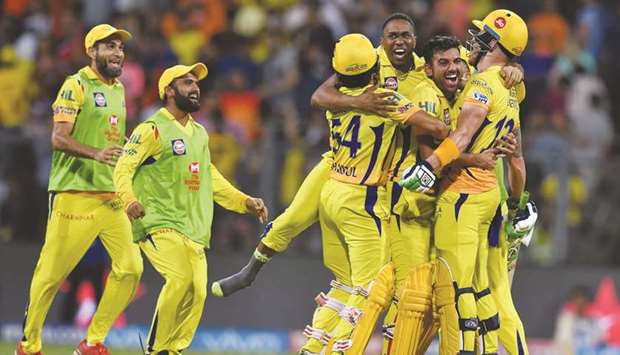Advertising rates for this season’s Indian Premier League cricket tournament have shot through the roof with a record 125 brands riding on the country’s most lucrative sports competition, far exceeding expectations of Star India, its new broadcaster.
With the final in Mumbai tomorrow, Star is already predicting its ad revenue from the 60-game tournament, which runs for just over seven weeks, will total about 20bn rupees ($300mn). That is up more than 50% from the 13bn rupees that was pulled in by the previous owner of the TV rights, Sony Pictures Networks, in 2017.
That will only partially offset the record 163.48bn rupees ($2.4bn) that Star India, which is part of Twenty-First Century Fox, paid last September for the television and digital rights of the IPL for five years.
But Star will make additional money from distribution and syndication rights and also get the benefits of pulling in viewers for other programming. There is also an increasing audience around the world in the Indian diaspora and from cricket fans generally.
“When we took it over we thought it is the biggest tournament,” said Star India Managing Director Sanjay Gupta. “But as we have gone through it we have realised it is even bigger than we thought it was... in its scale, in its depth, in the followership that you get.”
The success of the tournament, which only began in 2008, reflects not only the obsession with cricket in the world’s second-most populous nation but also the increasing demands from domestic and foreign companies for effective avenues to market their products to India’s growing middle class.
The Twenty20 format, which means each team can only bat for 20 six-ball overs, makes games much faster and more exciting than traditional cricket matches. Add in a lot of razzmatazz — dancers, fireworks, big screen replays and music — and the games played by male players appeal to a wide audience, including many women.
Star said it sold 90% of its advertising slots before the IPL kicked off on April 7 and the remaining 10% within the first two weeks of the tournament.
There was a 14% jump in television viewership for the first 52 of the 60 games, according to BARC ratings, which means the competition should easily surpass last year’s total viewership of 1.29bn when it ends on Sunday.
The brand value of the franchise-based IPL, which has eight teams, grew to an estimated $5.3bn in 2017, according to New York-based corporate finance advisory firm Duff & Phelps.
And the tournament is doing well beyond the traditional TV format. The match between Chennai and Hyderabad earlier this week set a new global record of 8.26mn concurrent viewers on Star’s video streaming platform, Hotstar — the highest-ever for a live event.
This Sunday’s final will be between Chennai and the winners of a playoff on Friday night between Kolkata and Hyderabad. Last year, the overall India viewership for the final reached 39.4mn, according to BARC.
More than 120 brands, ranging from those selling luxury cars to flipflops, are advertising during Star’s coverage of the IPL this year. They include online retailing behemoth Amazon, mobile carriers Vodafone and Reliance Industries’ Jio, smartphone maker Samsung, Coca-Cola and PepsiCo and automakers Ford, Tata Motors and Volkwagen AG’s Skoda.
Chinese smartphone maker Vivo Communication Technology is the title sponsor for the IPL after bidding almost 22bn rupees for a five-year contract last year.
Despite the higher advertising prices, the mood has been buoyant with the number of advertisers this year 40-50% more than in 2017, according to Vineet Sodhani, chief executive for media audit and advisory firm Spatial Access.
One of the big attractions is that the companies can choose to advertise in a variety of languages spoken in parts of India — not just English and Hindi — across a range of specialist Star channels and digital platforms.
“It (IPL) provides for us a very, very turbo-charged atmosphere,” said Siddharth Banerjee, executive vice president of marketing for mobile carrier Vodafone’s India unit, one of the advertisers. “It gives us a step jump which lasts us through the year. It’s like a shot that we take which gives us a lot of sustaining power.”
Mobile gaming firms are also among those to benefit. Mumbai-based Nazara Technologies partnered with the Bangalore team last year to launch a mobile game based on the side led by top Indian cricketer Virat Kohli.
“We got some amazing response,” Nazara Chief Executive Manish Agarwal said, referring to last year’s game.
“Within two days, we became the No. 1 game in the top free charts on Google Play (India).”
Agarwal added the new version of the game was also seeing massive demand from users this season.
Cricket historian Boria Majumdar said that there is likely to be a bigger Indian audience for the IPL this year than for the FIFA World Cup, the international soccer tournament held once every four years that is the most watched sports event in the world.
“For a domestic competition to have this level of interest is incredible,” he said.

Chennai Super Kings cricketers celebrate after winning the 2018 Indian Premier League (IPL) Twenty20 first qualifier cricket match against Sunrisers Hyderabad at the Wankhede stadium in Mumbai on May 22. The IPL is a virtual cash cow whose popularity shows no sign of waning 10 years after its launch.
